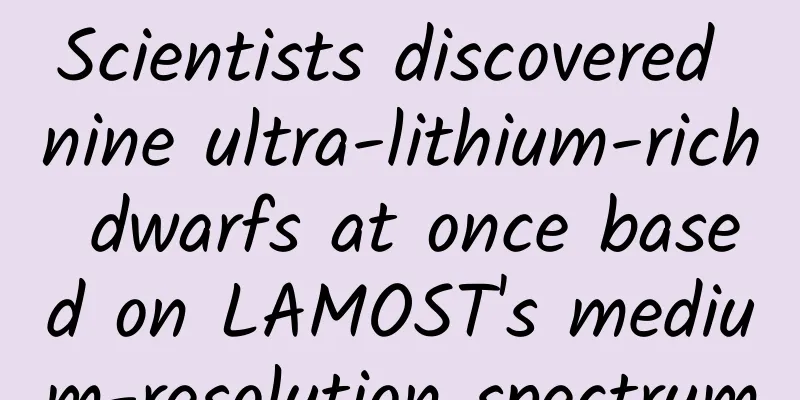Scientists discovered nine ultra-lithium-rich dwarfs at once based on LAMOST's medium-resolution spectrum

|
Author | LAMOST Operation and Development Center Recently, scientists have discovered nine unevolved stars with extremely high lithium content, namely super-lithium-rich dwarfs, based on the medium-resolution spectrum of LAMOST. The lithium content of one super-lithium-rich dwarf is 31 times that of the sun (4.8 dex). This discovery has set a new record for the lithium content of this type of star, making it the "lithium king" in the dwarf star world. Before this, astronomers had only discovered four similar super-lithium-rich dwarfs. What is the LAMOST medium-resolution spectrum, and why can it achieve such high-resolution results? Can this discovery reveal the relationship between the origin and evolution mechanism of lithium in super-lithium-rich dwarfs? 01 Do stars have different heights? Before we figure out what a super-lithium-rich dwarf is, we need to first understand what a dwarf is, and what a giant is. Stars, like humans, go through different stages of birth, growth, aging, and death. The size and temperature of stars change at different stages of their life cycle. Young and middle-aged stars in the stable main sequence stage are called dwarfs, and the stars at this time have not yet begun to evolve. After the hydrogen core in the center of the star burns out, the star will gradually evolve from the main sequence stage to a red giant. What continues to maintain the vitality of the red giant is the burning of the hydrogen shell outside the helium core. The expansion of the shell causes the star to "get fat", hence the name "giant". After that, the red giant will continue to evolve into a later red cluster star and an asymptotic branch giant. Stars in these evolutionary stages are all called "giants". Taking the sun we are familiar with as an example, the sun is currently a yellow dwarf star that has not yet evolved. When it evolves into a red giant, its volume will increase to about a million times its current size. Schematic diagram of the sun as a yellow dwarf that has not yet evolved. Image source: Veer Gallery 02 Where is the God of LAMOST medium-resolution spectroscopy? Four thousand optical fibers sweep across the sky, and tens of millions of spectra explore the universe. This is the Guo Shoujing Telescope (LAMOST), known as the "King of Spectra". LAMOST is a new optical astronomical telescope with a large field of view and a large aperture, independently developed by Chinese scientists and with many internationally pioneering technologies. It is also my country's first major national scientific and technological infrastructure in astronomy. In the past decade, LAMOST has led the development of international large-scale spectral survey projects and is the world's first survey tool to publish more than 10 million spectral data. Guo Shoujing Telescope | Image source: Science and Technology Daily From September 2012 to June 2017, LAMOST successfully completed the first phase of low-resolution spectral surveys. In October 2018, LAMOST officially launched the second phase of spectral surveys, which will be carried out alternately at medium and low resolutions and are expected to be completed in June 2023. The so-called low-resolution surveys are simply to obtain basic identity information of celestial bodies, while medium-resolution surveys can not only obtain basic identity information of celestial bodies, but also obtain detailed chemical DNA information, which can better understand the origin and evolution of celestial bodies. In recent years, astronomers have made full use of the absolute advantage of LAMOST's medium-resolution spectral data and achieved breakthrough progress in cutting-edge scientific fields such as the search for rare celestial bodies, stellar physics, and binary star evolution and properties. 03 Lithium is the key element to the secrets of the universe Lithium is a key element connecting the Big Bang, interstellar matter and stars. Its evolution in the universe and stars has always been an important topic in the field of astronomy. However, contemporary astronomy's understanding of lithium is still very limited. Previously, astronomers discovered that a very small number of evolved stars have abnormally high lithium content, which is called lithium-rich giants. In the past few years, LAMOST has made a series of breakthroughs in the study of lithium-rich giants, discovering more than 10,000 lithium-rich giants, which has deepened human understanding of such rare celestial bodies and the evolution of lithium in giants. The existence of lithium-rich giants indicates that there are unknown mechanisms in the process of stellar evolution that can significantly change the lithium content on the surface of stars. However, the nine peculiar super-lithium-rich dwarfs in this research result show that not only giant stars, but also a very small number of unevolved dwarfs show abnormally high lithium content. The lithium content of these nine super-lithium-rich dwarfs is at least three times higher than that of the sun. This means that these stars may have been formed in an environment with a higher lithium content than that near the sun, or that some special mechanism may have increased the lithium content on the surface of the stars. 04 Super lithium-rich dwarfs that have not yet evolved into giant stars Such super-lithium-rich dwarfs that have not yet evolved into giant stars are extremely rare. Astronomers have only discovered four in the past, so their formation mechanism is still poorly understood. There has been much controversy over the formation mechanism of such super-lithium-rich dwarfs that have not yet evolved into giant stars. Astronomers believe that atomic diffusion, accretion of surrounding lithium-rich matter by stars, or interaction between stars in binary systems and companion stars that causes abnormally high lithium content are all possible factors in the formation of super-lithium-rich dwarfs. This time, the researchers made full use of the advantages of LAMOST's multi-target medium-resolution spectral survey and discovered nine new super-lithium-rich dwarfs at one time. During the research process, the research team comprehensively considered the impact of various factors on the lithium content, and combined the LAMOST spectrum and the time-series photometry data of the US TESS space telescope. The results showed that seven of the super-lithium-rich dwarfs have high rotation speeds, all above 9 kilometers per second, which is about 20 times the rotation speed of the earth. The brightness of three of them has periodic changes, and one is in a binary star system. These observational evidences show that for most super-lithium-rich dwarfs, accretion of surrounding lithium-rich matter may be the main mechanism for the abnormal increase in their lithium content, but it does not rule out that a few of them are the result of binary star interactions. Paper link: https://iopscience.iop.org/article/10.3847/2041-8213/ac63a5 Produced by: Science Popularization China Producer: China Science Expo Special Tips 1. Go to the "Featured Column" at the bottom of the menu of the "Fanpu" WeChat public account to read a series of popular science articles on different topics. 2. Fanpu provides a function to search articles by month. Follow the official account and reply with the four-digit year + month, such as "1903", to get the article index for March 2019, and so on. Copyright statement: Personal forwarding is welcome. Any form of media or organization is not allowed to reprint or excerpt without authorization. For reprint authorization, please contact the backstage of the "Fanpu" WeChat public account. |
>>: Can this food prevent cancer? Not only can it not, it will also make you smell bad
Recommend
Analysts say the iPod product line will be replaced by the iWatch
Although Apple has not yet made it clear whether ...
Alipay released the 2016 national bill, 70% of payments were made on mobile devices
On the afternoon of January 4, Alipay , a subsidi...
520 Valentine's Day topic marketing!
Long time no see, everyone. In this episode of 5 ...
Cao Shichao's philosophy of life class delves into metaphysics and deciphers fate
Cao Shichao's Life Philosophy Class丨In-depth ...
How to create a hit on Douyin?
In July this year, the official TikTok revealed a...
Qianhang "How to sell furniture on Xianyu using free traffic"
Qianhang's resource introduction of "How...
Who are the most popular iOS and Android developers? Microsoft is one of them
[[266402]] Perhaps it is because the Windows Phon...
Comprehensive plan for Tik Tok short video marketing and promotion in 2019!
Follow the official account " Operation Uncl...
Daily Fresh Product Analysis
With the development of the Internet, many servic...
To do a good job in user operations, you need to start from these 6 aspects!
In the era of fan economy , the more users you ha...
How much does it cost to be an agent of Weinan Attendance Mini Program? What is the price of Weinan Attendance Mini Program agent?
What is the price of Weinan Attendance Mini Progr...
B station's complete set of promotion and traffic generation methods
Bilibili, abbreviated as B station, is a small br...
The dispute between "hard tofu" and "soft tofu" is because of this addition!
Audit expert: Wang Guoyi Postdoctoral fellow in N...
Operations Uncle: Why did the “single dog attribute” flood the circle of friends overnight?
Last night, yes, it was last night, the operation...
Let Chinese e-sports see hope, but the master said that playing professionally is more difficult than getting into Tsinghua University or Peking University
Recently, e-sports fans have received exciting go...









